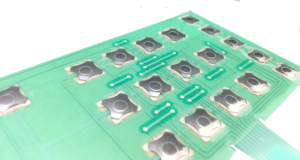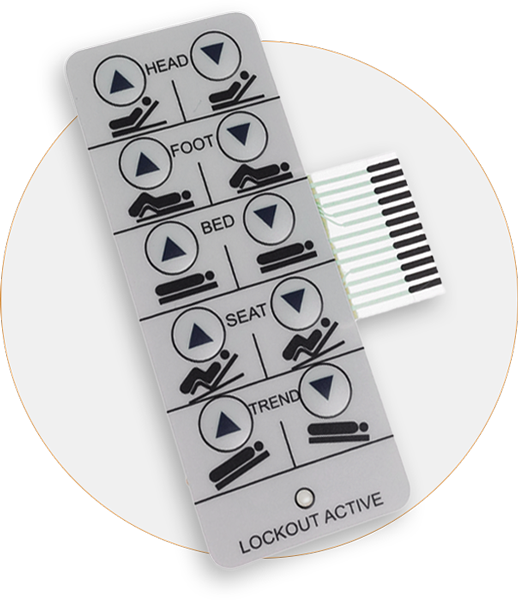Comprehending the Functionality of Membrane Layer Switches Over for User User Interface Instruments
The capability of membrane changes represents a substantial improvement in user interface style, incorporating effectiveness with aesthetic convenience. These switches operate with a multi-layered framework that converts customer interactions right into electrical signals, allowing for both compact layouts and resilience against environmental elements. As industries progressively focus on individual experience, comprehending the subtleties of membrane switch technology becomes important. What ramifications do these innovations hold for future applications, and exactly how might they redefine individual interactions across numerous gadgets?
What Are Membrane Layer Buttons?
Membrane buttons are innovative interface gadgets that help with customer communication with electronic equipment. These flexible elements are composed of numerous layers, including a visuals overlay, spacer, and a printed circuit layer. The design permits a seamless combination into various digital gadgets, boosting both the visual and functional facets of individual interfaces.
Membrane layer switches are commonly used in a wide variety of applications, from house devices to industrial equipment and clinical devices. Their construction usually features a thin profile, making them a perfect choice for compact designs. The responsive responses given by these buttons can be crafted to fulfill specific user preferences, ensuring reliable communication between the customer and the tool.
Sturdiness is one more considerable advantage of membrane buttons, as they are immune to dust, moisture, and chemicals, which boosts their life-span in requiring atmospheres. Furthermore, these switches can be customized in regards to form, dimension, and graphic layout, permitting branding and user-specific functions. In general, membrane layer changes stand for a useful service for boosting customer experience in electronic gadgets, incorporating capability with aesthetic charm in a reliable way.
Just How Membrane Layer Switches Work
Operating on an uncomplicated principle, membrane layer switches use a layered construction to register individual input successfully. Each switch includes numerous layers, consisting of a published circuit layer, a spacer layer, and a leading graphic layer, which are designed to work together effortlessly. When a customer presses the leading layer, it compresses the spacer layer, bringing the conductive elements of the circuit layer into contact with each other.
This contact produces a shut circuit, signifying the tool to execute a particular function. The style permits various setups, consisting of tactile comments, which can improve the individual experience by providing a physical experience upon activation. The materials utilized in membrane switches commonly consist of versatile substrates, such as polyester or polycarbonate, which ensure toughness and strength versus damage.

Key Benefits of Membrane Switches

An additional significant benefit is their density. Membrane layer switches are thin and light-weight, which makes it possible for producers to conserve space in their tools without sacrificing capability. This feature is specifically useful in applications where weight and volume are essential factors to consider.
Additionally, membrane buttons are resistant to dirt, dampness, and chemicals, enhancing their longevity. This resilience expands their lifespan and minimizes the demand for frequent substitutes, leading to price savings over time.
Additionally, the responsive feedback supplied by membrane layer buttons can be enhanced to boost customer interaction. They can include attributes such as elevated buttons or audible clicks, enhancing use and user experience.
Applications Across Industries
Interface gadgets making use of membrane switches are widespread in a broad variety of sectors, showcasing their flexibility and performance. Membrane Switch. In the clinical field, membrane layer switches are important to tools such as analysis tools and patient monitoring systems, where their sturdiness and convenience of cleansing are essential for preserving health criteria. In the automotive industry, these switches are employed in control panel controls and infotainment systems, offering a streamlined and modern-day user interface for individuals.
Furthermore, the consumer electronics industry take advantage of membrane layer buttons in blog here home appliances and handheld tools, where portable style and easy to use interfaces enhance customer experience. Industrial applications likewise leverage membrane switches over for control board in machinery and automation systems, highlighting their effectiveness and resistance to harsh environments.
In the aerospace and protection sectors, membrane buttons are utilized in cabin controls and tools, where dependability and performance under extreme conditions are vital. Furthermore, the gaming sector progressively includes membrane layer switches in controllers and arcade equipments, adding to an engaging user experience. On the whole, the convenience of membrane switches allows their widespread usage throughout numerous fields, highlighting their importance in modern-day customer interface style.
Future Patterns in Membrane Layer Change Modern Technology

In addition, using advanced products, such as polycarbonate and polyester films, is expected to rise, giving enhanced toughness and resistance to ecological stressors. These materials contribute to the general long life of membrane layer buttons, making them ideal for harsher industrial applications.
Additionally, the consolidation of wise modern technology, consisting of IoT connectivity, will allow membrane switches to interact with other devices and systems, helping look these up with a more interactive user experience. This trend aligns with the growing demand for wise gadgets throughout various markets, from medical care to customer electronic devices.
Last but not least, modification options are anticipated to broaden, enabling makers to develop bespoke solutions customized to certain customer demands and choices. These advancements will position membrane layer buttons as special info vital elements in the evolution of user interface technology.
Conclusion
In verdict, membrane switches over represent an essential advancement in individual interface technology, using a reliable and flexible remedy for diverse electronic applications. As improvements in material scientific research and touch picking up technologies continue, the capability and applicability of membrane layer switches are anticipated to increase, reinforcing their relevance in modern-day digital devices.